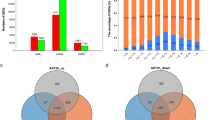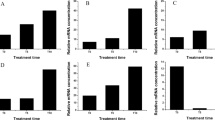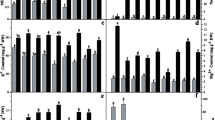Abstract
Main conclusion
This is the first report on the involvement of abscisic acid signaling in regulating post-germination growth under Cs stress, not related to potassium deficiency.
Abstract
Cesium (Cs) is known to exert toxicity in plants by competition and interference with the transport of potassium (K). However, the precise mechanism of how Cs mediates its damaging effect is still unclear. This fact is mainly attributed to the large effects of lower K uptake in the presence of Cs that shadow other crucial effects by Cs that were not related to K. RNA-seq was conducted on Arabidopsis roots grown to identify putative genes that are functionally involved to investigate the difference between Cs stress and low K stress. Our transcriptome data demonstrated Cs-regulated genes only partially overlap to low K-regulated genes. In addition, the divergent expression trend of High-affinity K+ Transporter (HAK5) from D4 to D7 growth stage suggested participation of other molecular events besides low K uptake under Cs stress. Potassium deficiency triggers expression level change of the extracellular matrix, transfer/carrier, cell adhesion, calcium-binding, and DNA metabolism genes. Under Cs stress, genes encoding translational proteins, chromatin regulatory proteins, membrane trafficking proteins and defense immunity proteins were found to be primarily regulated. Pathway enrichment and protein network analyses of transcriptome data exhibit that Cs availability are associated with alteration of abscisic acid (ABA) signaling, photosynthesis activities and nitrogen metabolism. The phenotype response of ABA signaling mutants supported the observation and revealed Cs inhibition of root growth involved in ABA signaling pathway. The rather contrary response of loss-of-function mutant of Late Embryogenesis Abundant 7 (LEA7) and Translocator Protein (TSPO) further suggested low K stress and Cs stress may activate different salt tolerance responses. Further investigation on the crosstalk between K transport, signaling, and salt stress-responsive signal transduction will provide a deeper understanding of the mechanisms and molecular regulation underlying Cs toxicity.







Similar content being viewed by others
Data availability
The RNA-seq data were submitted to NCBI Gene Expression Omnibus (GEO): GSE214426.
Abbreviations
- ABI5:
-
ABA insensitive 5
- ABR:
-
ABA-response protein
- AHG1:
-
ABA-hypersensitive germination 1
- CsCl:
-
Cesium chloride
- DEGs:
-
Differentially expressed genes
- HAI3:
-
Highly ABA-induced PP2C gene 3
- HAK5:
-
High-affinity K + transporter 5
- LEA7:
-
Late embryogenesis abundant 7
- TSPO:
-
Translocator protein
References
Adams E, Abdollahi P, Shin R (2013) Cesium inhibits plant growth through jasmonate signaling in Arabidopsis thaliana. Int J Mol Sci 14:4545–4559. https://doi.org/10.3390/ijms14034545
Adams E, Miyazaki T, Saito S, Uozumi N, Shin Y (2019b) Cesium inhibits plant growth primarily through reduction of potassium influx and accumulation in Arabidopsis. Plant Cell Physiol 60:63–76. https://doi.org/10.1093/pcp/pcy188
Adams E, Miyazaki T, Shin R (2019a) Contribution of KUPs to potassium and cesium accumulation appears complementary in Arabidopsis. Plant Signal Behav 14:1554468. https://doi.org/10.1080/15592324.2018.1554468
Ahn SJ, Shin R, Schachtman DP (2004) Expression of KT/KUP genes in Arabidopsis and the role of root hairs in K+ uptake. Plant Physiol 134:1135–1145. https://doi.org/10.1104/pp.103.034660
Ashraf MA, Kumagai S, Ito K, Sugita R, Tanoi K, Rahman A (2021) ATP binding cassette proteins ABCG37 and ABCG33 are required for potassium-independent cesium uptake in Arabidopsis roots. Mol Plant 14:664–678. https://doi.org/10.1016/j.molp.2021.02.002
Cui N, Song Z, Yang B, Fan L-M (2016) AtTSPO, a translocator protein, in stress responses in Arabidopsis. Environ Exp Bot 129:13–22. https://doi.org/10.1016/j.envexpbot.2015.12.002
Dias MC, Monteiro C, Moutinho-Pereira J, Correia C, Gonçalves B, Santos C (2013) Cadmium toxicity affects photosynthesis and plant growth at different levels. Acta Physiol Plant 35:1281–1289. https://doi.org/10.1007/s11738-012-1167-8
Dobin A, Gingeras TR (2015) Mapping RNA-seq reads with STAR. Curr Protoc Bioinform 51:11141–111419. https://doi.org/10.1002/0471250953.bi1114s51
Fujita Y, Nakashima K, Kanamori N, Katagiri T, Umezawa T, Kidokoro S, Maruyama K, Yoshida T, Ishiyama K, Kobayashi M, Shinozaki K, Yamaguchi-Shinozaki K (2009) Three SnRK2 protein kinases are the main positive regulators of abscisic acid signaling in response to water stress in Arabidopsis. Plant Cell Physiol 50:2123–2132. https://doi.org/10.1093/pcp/pcp147
Genies L, Martin L, Kanno S, Chiarenza S, Carasco L, Camilleri V, Vavasseur A, Henner P, Leonhardt N (2021) Disruption of AtHAK/KT/KUP9 enhances plant cesium accumulation under low potassium supply. Physiol Plant 173:1230–1243. https://doi.org/10.1111/ppl.13518
Guillaumot D, Guillon S, Morsomme P, Batoko H (2009) ABA, porphyrins and plant TSPO-related protein. Plant Signal Behav 4:1087–1090. https://doi.org/10.4161/psb.4.11.9796
Hong JH, Seah SW, Xu J (2013) The root of ABA action in environmental stress response. Plant Cell Rep 32:971–983. https://doi.org/10.1007/s00299-013-1439-9
Jung IL, Ryu M, Cho SK, Shah P, Lee JH, Bae H, Kim IG, Yang SW (2015) Cesium toxicity alters microRNA processing and AGO1 expressions in Arabidopsis thaliana. PLoS ONE 10:e0125514. https://doi.org/10.1371/journal.pone.0125514
Jung C, Nguyen NH, Cheong J-J (2020) Transcriptional regulation of protein phosphatase 2C genes to modulate abscisic acid signaling. Int J Mol Sci 21:9517. https://doi.org/10.3390/ijms21249517
Kanter U, Hauser A, Michalke B, Dräxl S, Schäffner AR (2010) Caesium and strontium accumulation in shoots of Arabidopsis thaliana: genetic and physiological aspects. J Exp Bot 61:3995–4009. https://doi.org/10.1093/jxb/erq213
Kobayashi D, Uozumi N, Hisamatsu S, Yamagami M (2010) AtKUP/HAK/KT9, a K+ transporter from Arabidopsis thaliana, mediates Cs+ uptake in Escherichia coli. Biosci Biotechnol Biochem 74:203–205. https://doi.org/10.1271/bbb.90638
Kobayashi R, Kobayashi N, Tanoi K, Masumori M, Tange T (2019) Potassium supply reduces cesium uptake in Konara oak not by an alteration of uptake mechanism, but by the uptake competition between the ions. J Environ Radioact 208–209:106032. https://doi.org/10.1016/j.jenvrad.2019.106032
Kumari S, Chhillar H, Chopra P, Khanna RR, Khan MIR (2021) Potassium: a track to develop salinity tolerant plants. Plant Physiol Biochem 167:1011–1023. https://doi.org/10.1016/j.plaphy.2021.09.031
Lai J-L, Luo X-G (2019) Comparative transcriptomics analysis of potassium uptake pathways mediated cesium accumulation differences and related molecular mechanisms in Brassica juncea and Vicia faba. Ecotoxicol Environ Saf 179:31–39. https://doi.org/10.1016/j.ecoenv.2019.04.043
Lara A, Ródenas R, Andrés Z, Martínez V, Quintero FJ, Nieves-Cordones M, Angeles Botella M, Rubio F (2020) Arabidopsis K+ transporter HAK5-mediated high-affinity root K+ uptake is regulated by protein kinases CIPK1 and CIPK9. J Exp Bot 71:5053–5060. https://doi.org/10.1093/jxb/eraa212
Li Y, Wang W, Wei K, Ruan L, Wang L, Cheng H, Zhang F, Wu L, Bai P (2019a) Differential transcriptomic changes in low-potassium sensitive and low-potassium tolerant tea plant (Camellia sinensis) genotypes under potassium deprivation. Sci Hortic 256:108570. https://doi.org/10.1016/j.scienta.2019.108570
Li Y, Wang Y, Tan S, Li Z, Yuan Z, Glanc M, Domjan D, Wang K, Xuan W, Guo Y, Gong Z, Friml J, Zhang J (2019b) Root growth adaptation is mediated by PYLs ABA receptor-PP2A protein phosphatase complex. Sci Adv 7:1901455. https://doi.org/10.1002/advs.201901455
Livak KJ, Schmittgen TD (2001) Analysis of relative gene expression data using real-time quantitative PCR and the 2−ΔΔCT method. Methods 25:402–408. https://doi.org/10.1006/meth.2001.1262
Ma T-L, Wu W-H, Wang Y (2012) Transcriptome analysis of rice root responses to potassium deficiency. BMC Plant Biol 12:161. https://doi.org/10.1186/1471-2229-12-161
Nam Y-J, Phan Tran L-S, Kojima M, Sakakibara H, Nishiyama R, Shin R (2012) Regulatory roles of cytokinins and cytokinin signaling in response to potassium deficiency in Arabidopsis. PLoS ONE 7(10):e47797. https://doi.org/10.1371/journal.pone.0047797
Nishimura N, Tsuchiya W, Moresco JJ, Hayashi Y, Satoh K, Kaiwa N, Irisa T, Kinoshita T, Schroeder JI, Yates JR 3rd, Hirayama T, Yamazaki T (2018) Control of seed dormancy and germination by DOG1-AHG1 PP2C phosphatase complex via binding to heme. Nat Commun 9(1):2132. https://doi.org/10.1038/s41467-018-04437-9
Paunov M, Koleva L, Vassilev A, Vangronsveld J, Goltsev V (2018) Effects of different metals on photosynthesis: cadmium and zinc affect chlorophyll fluorescence in durum wheat. Int J Mol Sci 19:787. https://doi.org/10.3390/ijms19030787
Qi Z, Hampton CR, Shin R, Barkla BJ, White PJ, Schachtman DP (2008) The high affinity K+ transporter AtHAK5 plays a physiological role in planta at very low K+ concentrations and provides a caesium uptake pathway in Arabidopsis. J Exp Bot 59:595–607. https://doi.org/10.1093/jxb/erm330
Rai H, Kuwabata M (2020) The dynamics of radio-cesium in soils and mechanism of cesium uptake into higher plants: newly elucidated mechanism of cesium uptake into rice plants. Front Plant Sci 11:528. https://doi.org/10.3389/fpls.2020.00528
Schneider CA, Rasband WS, Eliceiri KW (2012) NIH Image to ImageJ: 25 years of image analysis. Nat Methods 9:671–675
Seok H-Y, Nguyen LV, Nguyen DV, Lee S-Y, Moon Y-H (2020) Investigation of a novel salt stress-responsive pathway mediated by Arabidopsis DEAD-box RNA helicase gene AtRH17 using RNA-seq analysis. Int J Mol Sci 25:1595. https://doi.org/10.3390/ijms21051595
Su M, Huang G, Zhang Q, Wang X, Li C, Tao Y, Zhang S, Lai J, Yang C, Wang Y (2016) The LEA protein, ABR, is regulated by ABI5 and involved in dark-induced leaf senescence in Arabidopsis thaliana. Plant Sci 247:93–103. https://doi.org/10.1016/j.plantsci.2016.03.009
Trapnell C, Roberts A, Goff L, Pertea G, Kim D, Kelley DR, Pimentel H, Salzberg SL, Rinn JL, Pachter L (2012) Differential gene and transcript expression analysis of RNA-seq experiments with TopHat and Cufflinks. Nat Protoc 7:562–578. https://doi.org/10.1038/nprot.2012.016
Wang J-Y, Chen J-D, Wang S-L, Chen L, Ma C-L, Yao M-Z (2020) Repressed gene expression of photosynthetic antenna proteins associated with yellow leaf variation as revealed by bulked segregant RNA-seq in tea plant Camellia sinensis. J Agric Food Chem 68:8068–8079. https://doi.org/10.1021/acs.jafc.0c01883
Yang M, Tan L, Xu Y, Zhao Y, Cheng F, Ye S, Jiang W (2015) Effect of low pH and aluminum toxicity on the photosynthetic characteristics of different fast-growing Eucalyptus vegetatively propagated clones. PLoS ONE 10:e0130963. https://doi.org/10.1371/journal.pone.0130963
Yang D, Li F, Yi F, Eneji AE, Tian X, Li Z (2021) Transcriptome analysis unravels key factors involved in response to potassium deficiency and feedback regulation of K+ uptake in cotton roots. Int J Mol Sci 22:3133. https://doi.org/10.3390/ijms22063133
Yang S, Zhang Z, Chen W, Liang C, Li X, Liu Z, Cui Q, Ma Y, Zou X (2022) Fine-mapping and transcriptome analysis of the photosensitive leaf-yellowing gene CaLY1 in pepper (Capsicum annuum L.). Hortic Plant J 1–11:122–132. https://doi.org/10.1016/j.hpj.2022.06.007
Yoshida T, Christmann A, Yamaguchi-Shinozaki K, Grill E, Fernie AR (2019) Revisiting the basal role of ABA-roles outside of stress. Trends Plant Sci 24:625–635. https://doi.org/10.1016/j.tplants.2019.04.008625
Zhao Z, Zhang J-W, Lu S-H, Zhang H, Liu F, Fu B, Zhao M-Q, Liu H (2020) Transcriptome divergence between developmental senescence and premature senescence in Nicotiana tabacum L. Sci Rep 10:20556. https://doi.org/10.1038/s41598-020-77395-2
Funding
This work was supported by the RIKEN CSRS research fund.
Author information
Authors and Affiliations
Contributions
OWD and YM performed transcriptome data analyses. OWD conducted validation experiments and drafted the manuscript. TM conducted genotyping test of mutants. MM participated in the coordination of the study. RS conceived, revised, and edited the manuscript. All authors have read and approved the final manuscript for submission.
Corresponding author
Ethics declarations
Conflict of interest
All authors declare that we have no significant competing financial or professional interests that might have affected the work and presentation described in this manuscript.
Additional information
Communicated by Dorothea Bartels.
Publisher's Note
Springer Nature remains neutral with regard to jurisdictional claims in published maps and institutional affiliations.
Supplementary Information
Below is the link to the electronic supplementary material.
425_2023_4304_MOESM1_ESM.xlsx
Supplementary file1 Suppl. Data S1 List of differentially expressed genes with a false discovery rate of P < 0.05 and showing more than a 2-fold change in expression. (XLSX 263 kb)
425_2023_4304_MOESM3_ESM.jpg
Supplementary file3 Suppl. Fig. S2 Gene Ontology (GO) annotation of the genes with a significant fold change and false discovery cut-off. The charts represent the association of the low K-induced and Cs-induced genes in the molecular function (a), biological processes (b), and cellular components (c). Percentage represents the proportion of each GO term. (JPG 1237 kb)
425_2023_4304_MOESM4_ESM.jpg
Supplementary file4 Suppl. Fig. S3 Protein–protein interaction string network of low-K-induced DEGs related to nitrogen metabolism, photosynthesis, glucosinolate biosynthesis, flavonoid biosynthesis, pentose and glucuronate interconversions and plant hormone signal transduction. (JPG 1644 kb)
425_2023_4304_MOESM5_ESM.jpg
Supplementary file5 Suppl. Fig. S4 A representative of 8-day-old seedlings (WT and mutants) grown under low K and Cs conditions. (JPG 3119 kb)
Rights and permissions
Springer Nature or its licensor (e.g. a society or other partner) holds exclusive rights to this article under a publishing agreement with the author(s) or other rightsholder(s); author self-archiving of the accepted manuscript version of this article is solely governed by the terms of such publishing agreement and applicable law.
About this article
Cite this article
Ong, WD., Makita, Y., Miyazaki, T. et al. Arabidopsis transcriptomic analysis reveals cesium inhibition of root growth involves abscisic acid signaling. Planta 259, 36 (2024). https://doi.org/10.1007/s00425-023-04304-y
Received:
Accepted:
Published:
DOI: https://doi.org/10.1007/s00425-023-04304-y




